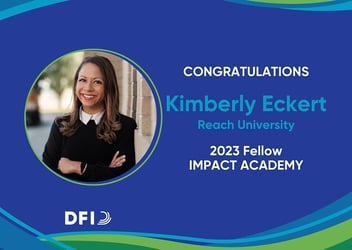HBS' Managing the Future of Work: Reach's apprenticeship degree model
Reach's stackable apprenticeship degrees:
"At the end of your first year with us, students earn a 30-credit early childhood educator certificate that then at the end of year two stacks into a 60-credit associates degree, that then at the end of four years stacks into a bachelor's degree, into a master's degree in teaching credential and so on. That stackability piece we think is very important because it allows students to earn more as they hit different milestones in their workplace. It also creates these one-way valves of maybe I have to step away from school for a while, but if I'm stepping away with an associate's degree. When we say apprenticeship degrees, we mean these are employer-driven experiences in which we turn an apprenticeship into an accredited degree and there's five defining features (known as the Reach Method).
 Reach's faculty:
Reach's faculty: Who they are: "100 percent of them are classroom educators. About half of them have been recognized in some way as a distinguished educator, and about a quarter of them are teachers of the year in their respective state."
How we engage them: "We're actually very intentional about trying to create a new labor model here for teaching that looks much like the medical profession —clinical faculty working in a hospital training residents. And so one of the things that we think is really important is that type of practitioner, someone who doesn't want to leave K-12, they want to be working in their workplace. In this case, inside of an elementary or middle or high school, and they want to then maybe be teaching a class for two hours a week, but mostly they want to be in the field doing this work. And so we like the idea of partnering with school districts where it's this third wave of we're now creating clinical faculty and individuals who are working for us and doing that as employees of their school district. And between those two, having two really important things happen that keep them in the labor market. So the first is that they're getting paid more. They're now getting paid basically a double salary so that we always talk about how teachers are underpaid... In many ways, it doesn't feel like two full-time jobs because it's the same thing. I'm going in and I'm working in my school every day, but now I'm getting paid a living wage that is actually competitive with the rest of the market. The other thing is it's giving a lot of these educators the chance to feel like they're still continuing to grow in their craft without leaving the classroom. There's significant evidence that apart from wash out of the first five years of teaching, the second place we lose educators isn't about the tenure mark because it feels like Groundhog Day. I'm good at what I do. There's nothing else for me to do until I retire. Our thesis here is that we can actually drive retention of our best teachers in the classroom at a place where we know we lose them in the labor market by rethinking the faculty structure and making them clinical faculty. Similar to what you would see at a medical school."
Balancing the needs of employers and an accredited institution of higher education:
"A big part of our process was just going and understanding when we talked to accreditors, what would need to be true for us to square their compliance requirements with what we were hearing from districts who were trying to use Grow Your Own initiatives and residency models and were complaining that it's costing too much money, it's taking too long, people are getting a ton of theoretical coursework that is in no way relevant to what I actually need them to know how to do. And so that was the journey of just first of all figuring out what is the actual product, what actually keeps both parties happy and delivers on something that is quality in terms of outcomes for our learners."
Reach's footprint today and where it goes next:
"Today Reach has 1,000 apprentices in about five states. If we honor our current commitments with state's partners, we will grow to about 10,000 apprentices over the next four years or so. But much more important than the work we're doing, there is a movement to stand up these teaching apprenticeships across the country. The Department of Labor and Department of Education at the federal level issued a joint call for all 50 states to stand up these apprenticeship methods in every single state and states are answering it. We are seeing every day more states launch these types of programs. And so while for us, we're really excited of the small piece that we're playing in this, what we're much more excited about is the potential for this to actually become a movement that fundamentally changes the nature of our supply pipeline, not only in terms of more teachers and more diverse and better distributed teachers, but teachers who their first day as an official teacher look a lot more like a fourth or fifth year teacher and have the quality to persist long-term in the classroom. And we think that this could end teacher shortages nationwide."
Success of Reach's program:
"We think about it in three terms, inputs, outputs, outcomes. On the input side, we are seeing exciting results. So over half of our teacher candidates are teachers of color, 90 percent are low-income 1st generation or working parents and 100 percent come from the communities they serve. Those indicators usually have a strong negative correlation with persistence in college. And despite that, our students persist through our programs at rates pretty much dead equal to white students from middle and affluent socioeconomic backgrounds in traditional programs. In terms of outputs, we include that in terms of praxis pass rates, satisfaction scores from our district partners and then persistence of contracts with our partners. Our students pass praxis rates about twice the state average when you disaggregate it by some of those cohort demographics before. It rates closer to about 3X the average in their geographies. We have a net promoter score of about 71 and 100 percent of districts who've started partnerships with Reach have continued them through this apprenticeship pathway. Outcomes. We have some early indicators and then there's data that we want and are trying to find a way to get our hands on. The one that we have is persistence. So at the graduate level, we do have five-year post-graduation data, and about 84 percent of our students are still in the classroom five years out from finishing our graduate program. About 91 percent are still working in a school. They might be an instructional leader, school leader, et cetera. We compare that to the average of people in their first five years, only about 40 percent of students or 40 percent of students wash out. Only about 60 percent persist. So we are seeing markedly higher persistence there."
Listen to the full podcast episode here.


